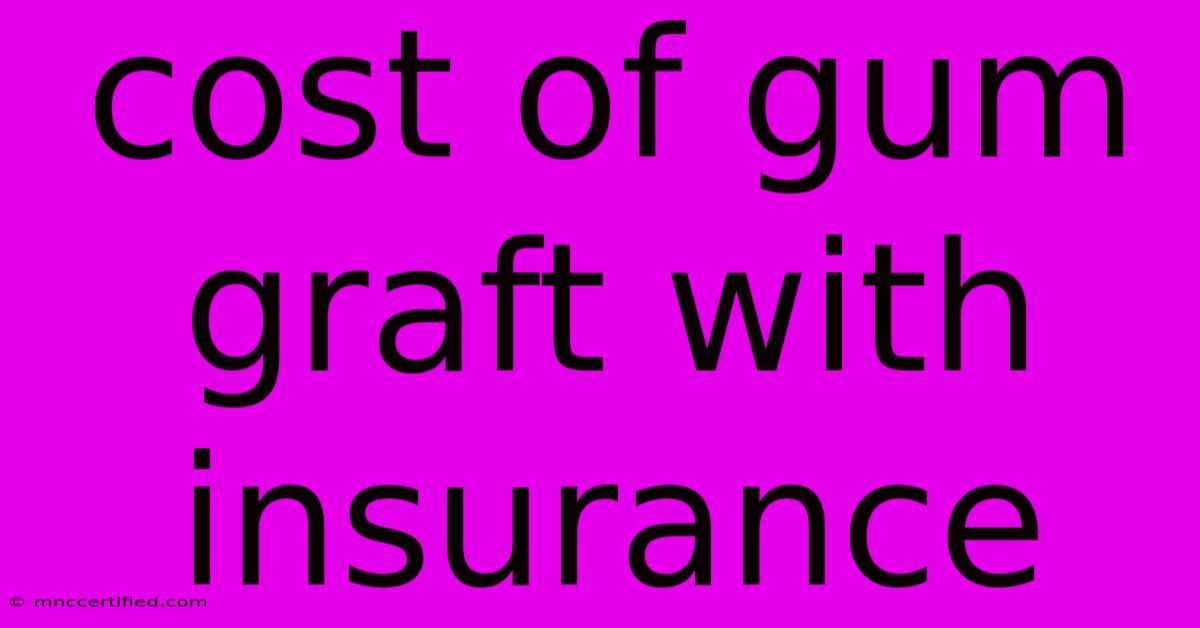Cost Of Gum Graft With Insurance

Table of Contents
Cost of Gum Graft with Insurance: A Comprehensive Guide
Getting a gum graft can significantly improve your oral health and aesthetics, but the cost can be a major concern. Understanding how insurance impacts the price is crucial before you proceed. This guide breaks down the cost of gum grafts, how insurance coverage works, and what you can expect to pay out-of-pocket.
Understanding Gum Graft Procedures
Before diving into the cost, let's clarify what a gum graft is. A gum graft, also known as a gingival graft, is a periodontal procedure where gum tissue is taken from one area of your mouth (or a donor site) and transplanted to another area where there's gum recession. This is commonly done to:
- Cover exposed tooth roots: Recession exposes sensitive tooth roots, making them vulnerable to decay and increasing discomfort.
- Improve aesthetics: Receding gums can make your teeth appear longer and less attractive.
- Prevent further recession: Addressing recession early can help prevent more extensive gum loss in the future.
There are different types of gum grafts, each with its own procedure and cost:
- Free gingival graft: Tissue is harvested from the palate (roof of your mouth).
- Pedicle graft: Tissue is partially detached and repositioned.
- Connective tissue graft: Tissue is taken from the palate, including underlying connective tissue, often considered the "gold standard" for coverage.
The Cost of Gum Graft Without Insurance
The cost of a gum graft varies greatly depending on several factors:
- Type of graft: More complex procedures like connective tissue grafts generally cost more.
- Extent of recession: Larger areas requiring grafting will naturally increase the cost.
- Location: Geographic location plays a role, with prices varying between states and even cities.
- Dentist's fees: Individual dentists may have different pricing structures.
Without insurance, you can expect to pay anywhere from $500 to $2,000 or more per graft site. Multiple sites needing grafting will significantly increase this cost.
How Insurance Affects the Cost
Most dental insurance plans partially cover gum grafts, classifying them as periodontal procedures. However, coverage varies widely depending on your specific plan:
- Check your policy details: Your plan's Summary of Benefits and Coverage (SBC) will provide specific information about periodontal coverage, including annual maximums and percentage reimbursement.
- Waiting periods: Many plans have waiting periods before periodontal coverage kicks in.
- Deductibles and co-pays: You'll likely have to meet your annual deductible and pay co-pays before insurance coverage begins.
- Pre-authorization: Some plans require pre-authorization for procedures like gum grafts. Always confirm this with your insurance provider.
Generally, you can expect your insurance to cover a percentage (often 50-80%) of the cost after meeting your deductible and co-pay. This means you will still likely have significant out-of-pocket expenses.
Minimizing Out-of-Pocket Costs
To minimize the cost of your gum graft:
- Shop around: Get quotes from multiple dentists in your area to compare pricing.
- Ask about payment plans: Many dental offices offer payment plans to make larger expenses more manageable.
- Explore financing options: Consider dental financing companies that provide loans specifically for dental work.
- Maximize your insurance benefits: Understand your policy thoroughly and ensure you've met all requirements before scheduling your procedure.
Conclusion: Planning for Gum Graft Costs
The cost of a gum graft with insurance is a complex issue. While insurance can help offset some of the expense, significant out-of-pocket costs are common. Thorough planning, research, and open communication with your dentist and insurance provider are crucial to managing the financial aspect of this important procedure. Don't hesitate to ask questions and explore all available options to ensure you can afford the care you need. Remember to always prioritize a qualified and experienced periodontist for the best results.

Thank you for visiting our website wich cover about Cost Of Gum Graft With Insurance. We hope the information provided has been useful to you. Feel free to contact us if you have any questions or need further assistance. See you next time and dont miss to bookmark.
Featured Posts
-
Is My Friend A Boba Addict
Nov 21, 2024
-
Hoa Board Of Directors Insurance
Nov 21, 2024
-
Missile Strike Russia Targets Ukraine
Nov 21, 2024
-
Do Metal Detectors Detect Copper
Nov 21, 2024
-
Hernia Surgery Cost No Insurance
Nov 21, 2024